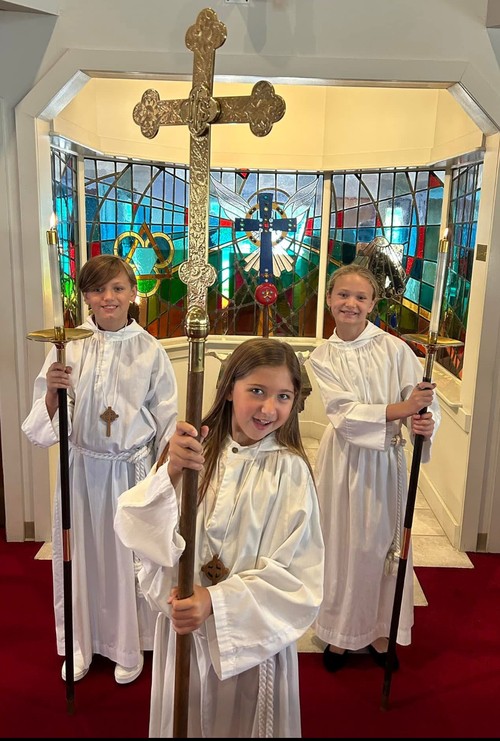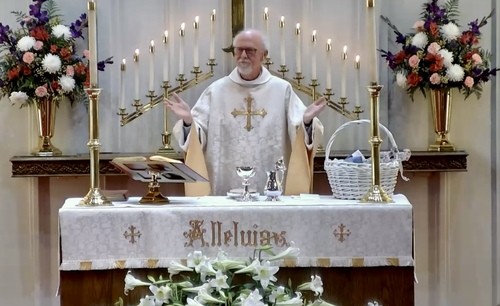Walking into a church service for the first time can be a confusing experience, especially if the church is of another Christian denomination or tradition. The information here is intended to eliminate at least a little of that confusion.
What you can expect during worship at St. James.
Our regular service is 10:30 a.m. each Sunday. The service liturgy is accompanied by organ and piano music as well as choir.
Families are encouraged to bring their children to all services. During the service, children ages 4 and up are invited just before the sermon to follow the cross and adult shepherds to the Parish Hall for Children’s Chapel, where they learn songs and experience the Bible lesson of the day in ways they can understand. They return to the main service at The Peace in time to join their families for Communion.
Families are encouraged to bring their children to all services. During the service, children ages 4 and up are invited just before the sermon to follow the cross and adult shepherds to the Parish Hall for Children’s Chapel, where they learn songs and experience the Bible lesson of the day in ways they can understand. They return to the main service at The Peace in time to join their families for Communion.

The principal weekly worship service for Episcopalians is called Holy Eucharist, also known as the Lord’s Supper, Holy Communion, or the Mass. When you worship with us on a Sunday morning, this is the service you will experience (except for the rare occasion that we celebrate Morning Prayer, which does not include communion).
The guide for all our services is The Book of Common Prayer, a red book with a cross on the cover that is found in all the pews. To help eliminate as much confusion as possible, however, we publish the entire service in a bulletin, which you will receive from an Usher upon entering the church. The blue Hymnal in the pews is the only other reference worshipers have to use during the service. The service hymns are listed in the bulletin handouts, as well as on the bulletin boards to the left and right of the alter.
The guide for all our services is The Book of Common Prayer, a red book with a cross on the cover that is found in all the pews. To help eliminate as much confusion as possible, however, we publish the entire service in a bulletin, which you will receive from an Usher upon entering the church. The blue Hymnal in the pews is the only other reference worshipers have to use during the service. The service hymns are listed in the bulletin handouts, as well as on the bulletin boards to the left and right of the alter.
Worship in the Episcopal Church is said to be “liturgical,” meaning that the congregation follows service forms and prays from texts that don’t change greatly from week to week. Some changes, however, do occur with the changes in seasons during the church year (Christmas, Easter, Lent, etc.). The relative sameness from week to week gives worship a rhythm that becomes comforting and familiar to the worshipers.
For the first-time visitor, liturgy may be exhilarating… or it might be a little (or a lot!) confusing. Standing, sitting, kneeling, sung or spoken responses, and other participatory elements that make our worship meaningful and beautiful can also be a challenge for the first-time visitor. Some longtime Episcopalians do things differently at different times – and that’s OK! Just know that liturgical worship can be compared with a dance: once you learn the steps, you come to appreciate the rhythm, and it becomes satisfying to dance, again and again, as the music changes.
The service of Holy Eucharist always has the same two major components:
The Liturgy of the Word and the Liturgy of the Table.
For the first-time visitor, liturgy may be exhilarating… or it might be a little (or a lot!) confusing. Standing, sitting, kneeling, sung or spoken responses, and other participatory elements that make our worship meaningful and beautiful can also be a challenge for the first-time visitor. Some longtime Episcopalians do things differently at different times – and that’s OK! Just know that liturgical worship can be compared with a dance: once you learn the steps, you come to appreciate the rhythm, and it becomes satisfying to dance, again and again, as the music changes.
The service of Holy Eucharist always has the same two major components:
The Liturgy of the Word and the Liturgy of the Table.
The First Part of the Service – The Liturgy of the Word

After the service begins with the singing of a hymn and a procession of the altar party and choir, we hear opening prayers and a set of Bible readings interspersed with more hymns or psalms. One of the readings is always from the Gospels. Next, a sermon based on the readings is preached, followed by a congregational recitation of the Nicene Creed, which was written in the fourth century and remains the Church’s statement of faith ever since.
Next, the congregation prays together – for the Church, the world, and those in need. We pray for the sick, thank God for all the good things in our lives, and finally, we pray for the dead. The celebrant (the priest leading the service) concludes with a prayer that gathers the petitions into a communal offering of intercession.
In certain seasons of the Church year, the congregation formally confesses their sins before God and one another. This is a corporate statement of what we have done and what we have left undone, followed by a pronouncement of absolution. In pronouncing absolution, the celebrant assures the congregation that God is always ready to forgive our sins.
The congregation then greets one another with a sign of “peace.” This manifests itself by parishioners greeting those in nearby pews. Then comes a brief time for parish announcements – some refer to this as the liturgical “halftime.”
The congregation then greets one another with a sign of “peace.” This manifests itself by parishioners greeting those in nearby pews. Then comes a brief time for parish announcements – some refer to this as the liturgical “halftime.”
The Second Part of the Service – The Liturgy of the Table

The second half of the service — The Liturgy of the Table — then begins with The Offering, that is, gifts gathered from the congregation and presented at the altar. The priest stands at the table, which has been set with a cup of wine and a plate of bread or wafers, raises his or her hands, and greets the congregation again, saying “The Lord be With You.” The Eucharistic Prayer follows, in which the celebrant tells the story of our faith, from the beginning of Creation, through the choosing of Israel to be God’s people, through our continual turning away from God, and God’s calling us to return. Finally, the celebrant tells the story of the coming of Jesus Christ, and about the night before his death, on which he instituted the Eucharistic meal (communion) as a continual remembrance of him. The celebrant consecrates – that is, asks God’s blessing on – the bread and wine. We say the Lord’s Prayer together. And finally, the celebrant breaks the bread and offers it to the congregation, as the “gifts of God for the People of God.”
The congregation then shares the consecrated bread and the wine. At St. James, we come to the altar rail, one pew at a time. Many consume the bread first, then sip from the chalice as it is brought to them. Others intinct, or dip, the wafer into the chalice before consuming it. Still others have reason to consume either only the bread or only the wine, which is fine and considered full and valid communion.
All baptized Christians, regardless of age or denomination, are welcome to receive communion. Those not baptized still are welcome to come forward during Communion to receive a blessing. You can indicate this by crossing your arms across your chest as the priest approaches.
At the end of the Eucharist, the congregation prays once more in thanksgiving, and then is dismissed to continue the life of service to God and to the world.
The congregation then shares the consecrated bread and the wine. At St. James, we come to the altar rail, one pew at a time. Many consume the bread first, then sip from the chalice as it is brought to them. Others intinct, or dip, the wafer into the chalice before consuming it. Still others have reason to consume either only the bread or only the wine, which is fine and considered full and valid communion.
All baptized Christians, regardless of age or denomination, are welcome to receive communion. Those not baptized still are welcome to come forward during Communion to receive a blessing. You can indicate this by crossing your arms across your chest as the priest approaches.
At the end of the Eucharist, the congregation prays once more in thanksgiving, and then is dismissed to continue the life of service to God and to the world.
